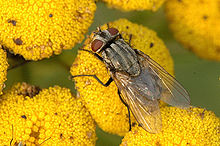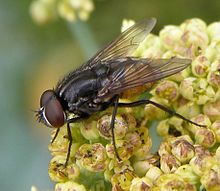- Musca autumnalis
-
Musca autumnalis 
Scientific classification Kingdom: Animalia Phylum: Arthropoda Class: Insecta Order: Diptera Family: Muscidae Genus: Musca Species: M. autumnalis Binomial name Musca autumnalis
De Geer, 1776Synonyms Musca autumnalis, the face fly or autumn house-fly, is a pest of cattle and horses
Contents
Description
The face fly is similar to the closely related house fly. Slightly larger, averaging about 7 - 8 mm long and Grey in colour with 4 dark stripes on the thorax, with a grey-black patterned abdomen. Like many true flies, in the males, the eyes almost touch when viewed from above. [1]
Distribution
Musca autumnalis is widespread throughout Most of Europe, Central Asia, also North India, Pakistan, China, and some parts of North Africa.
It has been introduced into North America around the 1940s, and now spread to cover from Southern Canada into most temperate parts of the United States. also introduced to St Helena Island in the South Atlantic[2]
Life cycle
Adult flies will emerge from winter hibernation around March to early April. Daytime they feed on manure juices and plant sugars. On cattle and horses they feed on secretions of the facial orifices, around the eyes, mouth and nostrils. The adult flies will also feed on the hosts blood through wounds such as Horse-fly bites. A larger proportion of face flies on the host will be females, as they have a higher need for protein provided by animal hosts. Night time both sexes will rest on vegetation
Females deposit eggs on fresh cow manure, and these hatch within hours post deposition. The yellowish white maggots feed on the microbial flora and fauna of the manure and pass though three larval stages (instars), growing to about 12 mm long. Then develop into a white pupa. Emerging as Adults approximately 10 to 20 days after egg deposit, dependent on temperature.
As a vector of disease
Musca autumnalis is considered a pest species, as it transmits eyeworm Thelazia rhodesi to cattle and horses, and Pinkeye (Infectious bovine keratoconjunctivitis) in Cattle.
References
- ^ Gregor, F.; Rozkosny, R.; Bartak, M.; Vanhara, J. (2002). The Muscidae (Diptera) of Central Europe. Scientiarum Naturalium Universitatis Masarykianae Brunensis. 107. Masaryk.: Masaryk University. pp. 280pp.
- ^ Pont, A.C.; Werner, D.; Kachvoryan, E.A. (2005). A preliminary list of the Fanniidae and Muscidae (Diptera) of Armenia. Zoology in the Middle East 36. pp. 73–86 pp.
This article related to members of the insect family Muscidae is a stub. You can help Wikipedia by expanding it.

